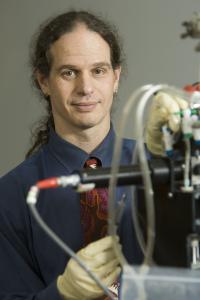|
Related Topics: |
|
|
|
Current News |
|
Chemistry A to Z |
|
About Internetchemistry |
WFU researchers discover new hemoglobin function |
|
A team of researchers from Wake Forest University, the National Institutes of Health and other institutions has discovered a previously undetected chemical process within the oxygen-carrying molecule hemoglobin that could have far-reaching implications for the treatment of cardiovascular diseases. In a paper published online Nov. 4 (2007) in the journal Nature Chemical Biology, senior authors Daniel Kim-Shapiro, professor of physics at Wake Forest, and Mark Gladwin, chief of the Vascular Medicine Branch of the National Heart, Lung and Blood Institute of the NIH, describe how hemoglobin, through a catalytic reaction that does not change its own chemical properties, converts nitrite salt to the vasodilator nitric oxide. The paper further documents how the nitric oxide activity harnessed by hemoglobin escapes the red blood cell to regulate blood flow and how the process, surprisingly, relies on the oxidized, or rusted, form of hemoglobin, previously associated only with diseased states. |
|
�We believe we have solved the paradox of how hemoglobin mediates the conversion of nitrite to nitric oxide in a way that it is not immediately destroyed in the red cell and so it can be effective biologically,� Kim-Shapiro says. In the bloodstream, iron-rich hemoglobin consumes, on contact, any free nitric oxide released by the blood vessels, so the idea that hemoglobin participates in forming nitric oxide had seemed implausible until recently. In 2003, Gladwin and collaborators at the NIH, Wake Forest and the University of Alabama discovered that nitrite salt, the same substance used to cure meat and previously thought to be biologically inert, serves in the cell as a storage pool for nitric oxide. Since then, nitrite has been the object of intense study by researchers worldwide in pursuit of new treatments for such conditions as sickle cell disease, myocardial infarction, pulmonary hypertension, stroke and atherosclerosis. In the most recent study, the researchers conclude that the nitrite-hemoglobin reaction generates dinitrogen trioxide (N2O3), which takes one of several pathways from the red blood cell and later separates into nitric oxide (NO) and nitrogen dioxide (NO2). The newly discovered chemistry in hemoglobin has eluded scientists for a century because the intermediate molecule, nitrite-methemoglobin, formed during the process cannot be observed by electron paramagnetic resonance spectroscopy, the most sophisticated analysis technique currently available. That has rendered the reaction �invisible� by direct observation, but indirect measurement of the process is possible. �Using a variety of biophysical techniques and by careful examination of the rates of reactions and the products that are made when experimenting with hemoglobin and nitrite, we were able to discover this reaction mechanism,� Kim-Shapiro explains. The research was funded by grants from the NIH. |
|
|
|

